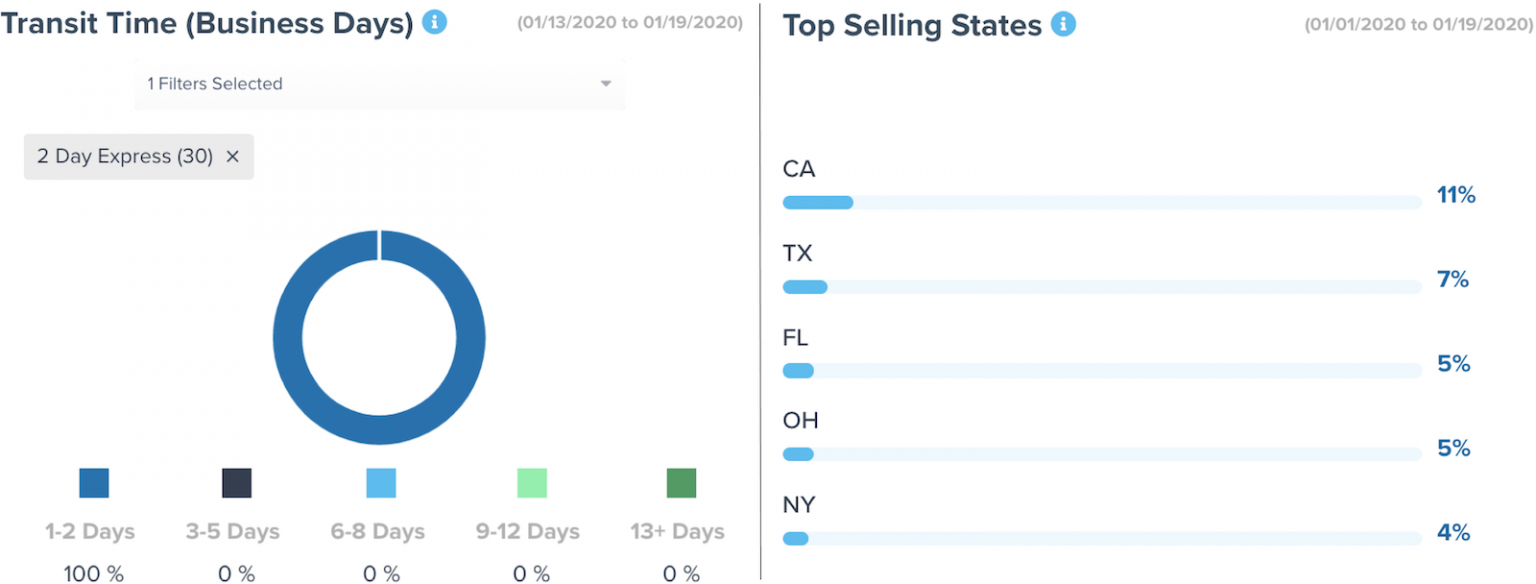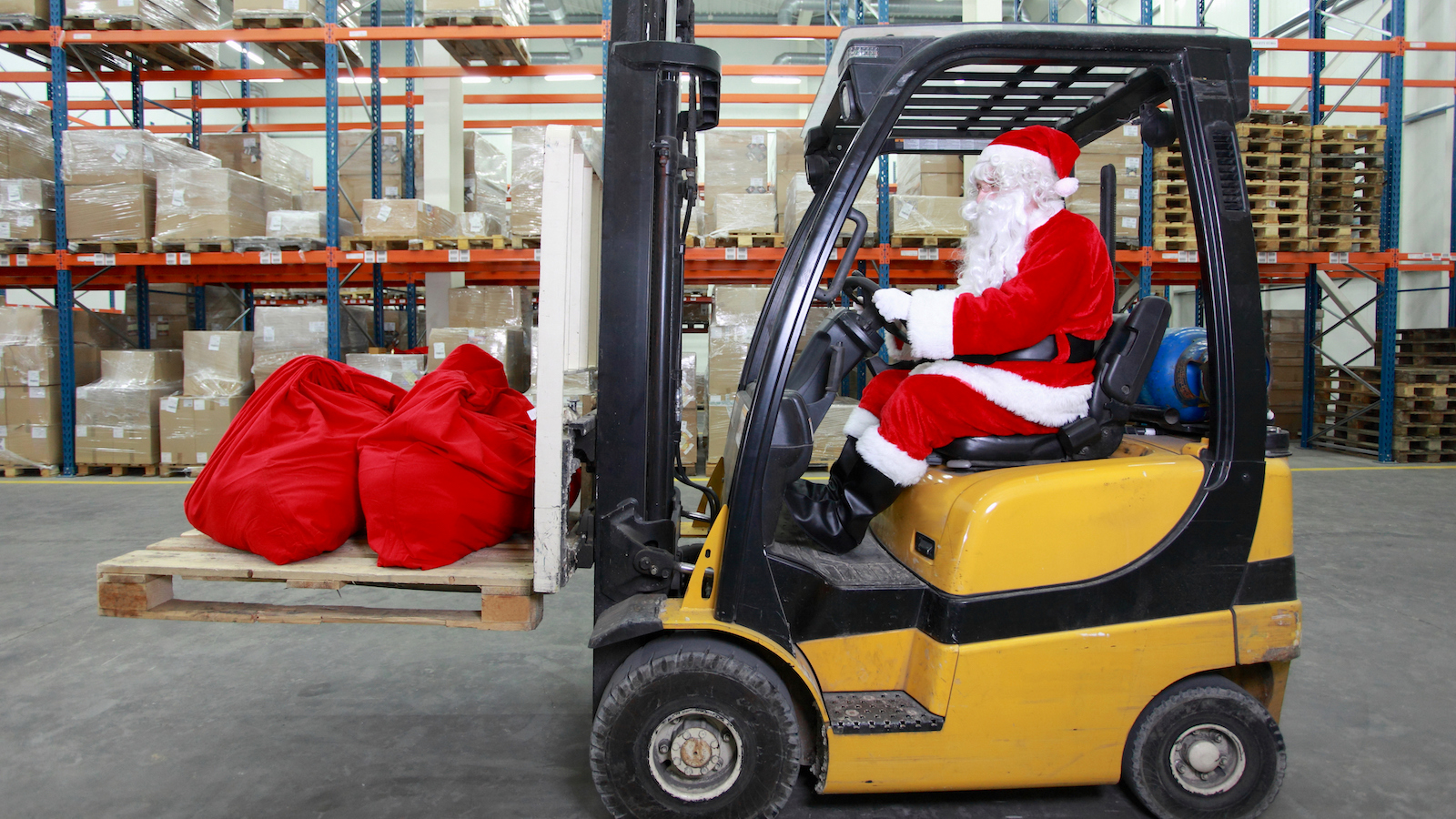Table of Contents
** Minutes
When does peak shipping season start & finish?
Common peak shipping season challenges
10 ways you can get your store ready for peak shipping season
There are a couple of months a year where most ecommerce brands can expect a surge of orders and product demand — the holidays!
The holiday season is the most important time of the year for direct-to-consumer (DTC) brands. In order to keep up with the unprecedented volume in such a short time span, it’s important you have the right shipping strategy and fulfilment processes in place.
Since it’s the season of gift-giving, expect a surge of ecommerce returns as well.
As customers expect more from their online shopping experience – free returns, free and fast shipping, and even share-worthy unboxing moments – those who keep up logistically will bring in more customers and keep them coming back.
In this article, you will learn about the common challenges DTC brands face during peak shipping season, and how you can prepare your online store for success.
What is peak shipping season?
Peak shipping season refers to the time of year (Q4, or October through December) when order and shipment volume see an influx, leading to more orders to fulfil and returns to process, due to the busy holiday shopping season surrounding popular shopping days including Black Friday, Cyber Monday, and general gift-giving leading up to Christmas.
During this time, supply chain efficiencies can get disrupted as online brands try to keep up with demand, managing inventory and fulfilling a high volume of orders, while shipping couriers become busier than usual, working hard to deliver packages on time.
When does peak shipping season start & finish?
Peak shipping season begins earlier than many people think — both ecommerce sales and the shipping industry fully ramp up as early as October, and demand continues until the new year. It’s important to note that after the last holiday season, these timelines may be extended and start even earlier.
Here is an overview of key milestones and holidays that occur during peak shipping season.
Halloween (October 31)
Although it’s an American holiday, Halloween is still popular for many consumers across Europe. Whether you sell “spooky” decorations and costumes or other items, the opportunities for sales increase during this time. Many brands will capitalise on the holiday and run special promotions.
Thanksgiving (November 28)
Thanksgiving marks the start of holiday shopping season with Black Friday, Small Business Saturday, and Cyber Monday all occurring over one long weekend (this year’s dates are listed below). This is the time when holiday shoppers start to search for the best deals and get a head start on purchasing holiday gifts.
Christmas (December 25)
Holiday shoppers expect to have their gifts delivered before Christmas Day (or Christmas Eve). It’s crucial to take note of the couriers’ holiday cutoff dates (and pad in extra time to be safe) and communicate those with your customers, so they know when they should place an order if they want their orders to arrive on time.
New Year’s Day (January 1)
Although the holiday shopping season starts to slow down by this time, return volume is near an all-time high. This time often requires more from customer service and logistics operations teams, so returns and exchanges can be processed efficiently.
Other important dates to note:
- Black Friday: November 29
- Small Business Saturday: November 30
- Cyber Monday: December 2
- Boxing Day: December 26
Common peak shipping season challenges
Expected or unexpected, any time there is a major shift in the supply chain, it can throw off your entire operations, from inventory management to shipping.
That’s why it’s important to find ways to build supply chain resilience, so you can ensure a successful peak shipping season despite delays and disruptions.
To prepare your supply chain for Q4, here are some common peak shipping season challenges to be aware of.
Black Friday sales
One of the biggest challenges for growing ecommerce businesses is managing an increase in order volume, which is most apparent during the holidays. Black Friday sales cut right through the peak shipping season and add more chaos to the mix.
Partnering with the right 3PL like ShipBob takes the challenges of fulfilment off your plate and into the hands of experts (even when volume increases by 1,200% in a couple weeks). That way, you can avoid making common holiday season mistakes.
But if you keep fulfilment in-house, be prepared to hire more packers (and even be ready to ask friends and family to step in as needed). You’ll also have to plan your holiday(s) around running promotions and fulfilling orders in a timely manner.
Suppliers on holiday or factory shutdowns
More brands are partnering with multiple suppliers or manufacturing options to ensure they are not left at risk or without inventory replenishment when a primary supplier is unable to deliver during shortages, shutdowns, or even to help offset trade restrictions.
Whether it’s a planned shutdown like Chinese New Year or unplanned like forces from the pandemic, manufacturers can hit peak capacity or face shutdowns at any time, which means receiving and replenishing inventory can be significantly delayed, which disrupts the entire ecommerce supply chain.
As part of your business contingency or continuity plan, partnering with different suppliers can help reduce risk of inventory shortage, despite the circumstances, so you can be sure to meet customer demand despite any delays in receiving more ecommerce inventory.
You can also get ahead of ordering more inventory to prevent stockouts and have more buffer inventory on hand during the peak shipping season.
Inexperienced 3PLs
If you decide to partner with a 3PL, be sure they have the expertise, technology and experience in dealing with the peak shipping season. The wrong 3PL partner can cause major hiccups in your fulfilment process, leading to mispicks, misshipments, inaccurate inventory levels, and slower deliveries.
The right 3PL should always offer transparency and visibility into your supply chain, including real-time inventory data, shipping and fulfilment performance, and more.
If you already have a 3PL partner but are unsatisfied with their services, you might want to consider switching 3PLs sooner than later. Partnering with a technology-enabled 3PL like ShipBob can help you get onboarded quickly to ensure a smooth peak shipping season.
“Q4 was hard for ecommerce brands between the election (causing ad spend to increase), the pandemic, the couriers being overloaded and overburdened, and other competitive forces and costs.
Speaking with friends who run other brands, including those that do $200 million in annual revenue, I learned they faced the same issues.
Being with ShipBob this past Q4 went a lot better than most companies experienced.
We know some brands still with our old 3PL who struggled a lot. For them, it would take 5-6 days to get orders fulfilled, and they had to cut holiday sales very early.
We of course experienced some challenges with the holidays and pandemic like every company, but it was a very small percentage in comparison.
ShipBob was a great partner to get us through Black Friday and the holidays.”
Torii Rowe, COO & Co-Founder of MANSSION
10 ways you can get your store ready for peak shipping season
Starting with your online store’s user experience to optimising inventory, here are several ways you can get your store ready for the busiest season of the year.
1. Plan ahead
To plan ahead, utilise data as much as possible, think through planned promotions, and decide how you will handle massive influxes in demand.
By forecasting demand, you can optimise stock levels and make better decisions around how much of each SKU to reorder and when.
Though inventory forecasting is never 100% accurate, there are steps you can take to get your estimates closer to actuals:
- Look at historical data and seasonality.
- Think through planned promotions and anticipated spikes.
- Optimise stock levels by tracking fast-selling vs. slow-moving items.
In the event that there’s a stockout, you will want to establish a process that marks orders as “out of stock” on your store right away, so you and your customers have a clear understanding of current stock availability.
In the event that you accumulate dead stock, you can run a promotion or a flash sale to make room for in-demand inventory.
2. Give your customers a heads up
Since Q4 is the busiest time for peak shipping season shipping, ecommerce brands must pay attention to courier cutoffs for each service (even padding in extra time) as well as courier transit time performance to communicate any potential delays to customers.
Last-mile delivery plays a key role in customer satisfaction, but unfortunately delays happen. In case of delays, be proactive and communicate with customers about any potential delays as soon as possible.
Also take close note of courier holiday shipping deadlines when they become available, so you can let your customers know when holiday orders must be placed to have orders fulfilled and shipped on time.
You also need to keep a close eye on inventory levels. In the event of a stockout, make sure to mark products as “out of stock” on your store right away, and don’t over-highlight or promote these products (even in set-it-and-forget-it mediums like retargeting ads), unless you have a sound backorder strategy.
As always, be sure you offer your customers order tracking, so they can track orders in real time.
3. Partner with an experienced 3PL
Partnering with an experienced third-party logistics (3PL) company like ShipBob can help make the chaotic holiday season a lot more manageable, especially if you’re:
- Hoping to transition fulfilment from your home to a professional
- Preparing to launch a new brand
- Looking to move from managing your own warehouse or do a hybrid approach
Fulfilling holiday demand on your own is very challenging, and leasing your own warehouse is expensive and time-consuming.
The sooner you get started with a 3PL, the easier it will be. If you’re in a time crunch to get started with a 3PL, ShipBob can help you get onboarded fast, so you’re prepared for the busy holiday season.
For example, Brummel got started with ShipBob right before the holiday season and had a successful Q4.
“Looking back, I’m still not sure how we pulled everything off, and I have no clue what I would have done if I tried it myself. I probably would have recruited a ton of friends to pack boxes and bring hundreds of shipments to the post office at one time, which would be terrible.”
Steve Staffan, Founder and CEO of Brummell
For guidance on how to choose the right 3PL, click here.
4. Ramp up customer service agents
You’ll want to ramp up staffing for your customer service team, as you’ll likely experience higher-than-normal inquiries due to the influx of orders and even delays from couriers.
Your online store will be experiencing more shoppers and orders than usual, so the more support you have for your customers at the times and channels they want, the better.
Make sure your team is knowledgeable of courier cutoff dates, current promotions, the different shipping options available, expected delivery timeframes, and how to return or exchange items quickly.
5. Communicate with your suppliers
Work closely with your manufacturer or supplier by sharing predicted Q4 order volume ahead of time — as soon as possible — to avoid potential stockouts during the holiday season. Work in longer than normal lead times, due to not only Q4 demand, but port delays and other supply chain issues.
By understanding production lead times, you lower the risk of stockouts, backorders, and running promotions on out-of-stock items.
Some brands even look to diversify their manufacturer mix with multiple partners in different areas to reduce risk if their primary supplier is unable to replenish according to plan.
If you work with a 3PL, be sure to note when their inventory receiving cutoffs are for the holidays, since their backlog will be higher than normal. Factor all of these variables into your lead time calculations to replenish even earlier this year.
6. Implement the latest supply chain technologies
Before the peak shipping season begins, think through your supply chain technology stack including:
- Warehouse management system (WMS)
- Inventory management software (IMS)
- Order management
- Automated order processing
- Returns management
- Ecommerce fulfilment and ecommerce shipping technologies
A streamlined tech stack has the ability to optimise speed and increase order accuracy. It also provides accurate data in real time that can be shared with multiple third-parties.
If you’re looking to optimise your supply chain prior to peak shipping season, it’s not too late to implement technology into your supply chain.
If you work with a 3PL like ShipBob, you get access to premium technology and direct integrations with leading ecommerce solutions, from inventory planning to returns management.
“Since partnering with ShipBob, we now have an automated system for shipping and can focus our time on new product launches. We continually are able to reliably and quickly fulfil thousands of orders during a single apparel drop. This partly has to do with ShipBob saving us time by automating the order fulfilment process.”
Jason Ton, CFO of 100 Thieves
7. Store inventory across multiple warehouses
If you partner with a 3PL especially, you have the opportunity to distribute inventory across multiple fulfilment centres to optimise shipping costs and reduce transit times.
For instance, ShipBob offers locations across the globe. Since every location is powered by the same best-in-class technology, you get access to data tools to help you understand which regions (and countries) are generating the most sales, so you can optimise your inventory allocation strategy accordingly.

By utilising a distributed inventory method, you’re able to offer competitive, fast, and affordable shipping options that meet customer expectations (such as 2-day or free shipping with a minimum spend threshold that’s above your AOV or average order value).
8. Stock up on extra shipping materials
The last thing you want to do is slow down fulfilment due to a shortage of packaging materials, so be sure to stock up on boxes, poly mailers, and other supplies that you need if you keep fulfilment in-house.
Additionally, you will want to think through ways to make your brand stand out this holiday season. For example, you can make the unboxing experience memorable by using custom packaging, marketing inserts, and gift notes.
In the age of social media, a remarkable unboxing experience can delight your customers and increase the chance that they’ll share the experience with their friends and social media followers.
“I wanted a good unboxing experience and would wrap each pack in tissue paper and add a sticker. I spent about 3 minutes per order on fulfilment. I almost didn’t want orders to come in. I had to find a fulfilment partner and began looking for an all-in-one solution. ShipBob was the exact solution I was looking for.”
Leonie Lynch, Founder & CEO of Juspy
9. Utilise multiple shipping couriers
By using multiple shipping couriers, you have more shipping flexibility. But partnering with multiple shipping couriers can be a lot of work, and it can also cause you to dip under the minimum shipping threshold to qualify for discounted shipping rates.
Luckily, a 3PL can help. ShipBob partners with major global couriers (UPS, USPS, FedEx, DHL, and more) and regional parcel couriers (CDL in the East Coast, United Delivery Service in the Midwest, Lone Star Overnight in Texas, and On Trac in the West Coast).
This will help you optimise your shipping strategy without the need to manage multiple partners on your own. ShipBob also negotiates bulk shipping rates to pass the savings on to you.
“Running a music label, order volume fluctuates as it is based on certain times when an album drops. We don’t have continuous promotions running, and months can go by before a new physical product is ready to sell. I also couldn’t get order volume discounts if I set up an account with DHL or FedEx on my own, which have steep minimums.”
Lee Nania, Founder of SubSubmarine
10. Establish a returns management process
No matter the time of year, be sure to have a well-defined returns and exchange policy in place that is easy to understand and accessible on your online store or product listings.
Having a proper returns management process in place can improve brand loyalty and maintain sales by making the returns process as simple as possible for the customer.
A great returns experience can also encourage your customers to make an exchange, so you don’t lose out on a sale.
Revisit your returns policy as needed and make sure you’re not losing money. Review which products are getting returned most, determine why, and consider making changes to products and/or product descriptions to set better expectations.
“For reverse logistics, we have also been leveraging ShipBob’s Returns API to automate and streamline our routine RMA processes. Having ShipBob handle our returns has been a huge help in reducing our daily workload, and the ability to drive this process via API is wonderful.”
Waveform Lighting Team
Get ready for peak shipping season with ShipBob
This year, ecommerce brands must get ahead of holiday demand to ensure a high volume of orders will be fulfilled accurately and quickly. With online sales during the holidays expected to break records again, your business must be prepared.
The best way to get ready for peak shipping season and meet customer expectations is to make sure that every part of your supply chain is aligned.
Rather than managing a warehouse, investing in your own fulfilment tech stack, and shipping orders yourself, you can outsource fulfilment to a 3PL expert like ShipBob while saving time and money in the long run.
“Our experience with ShipBob has been outstanding thus far. This past Q4 was really good, with December being our best month yet, even though it was really competitive. ShipBob was solid during the holidays, and at one point they even paid for expedited shipping for everyone, keeping their customers happy.”
Josh Hollings, Founder & CEO of Drop FX
ShipBob’s international fulfilment network is powered by the same premium 3PL software, which provides real-time inventory and order tracking, as well as visibility into fulfilment and shipping performance.
“Our order volume has seen ebbs and flows, and ShipBob has fulfilled over 10,000 shipments per month for us, with Black Friday/Cyber Monday and our summer season being our most in demand times of the year.
We also have to make changes to product bundles on the fly with complete control and visibility, which is important in monthly subscription boxes, holiday bundles, and many more scenarios. With our past 3PL, we had to rely on a game of telephone and someone else to do this for us.”
Gerard Ecker, Founder & CEO of Ocean & Co.
ShipBob even integrates directly with the leading ecommerce customer service and helpdesk platform, Gorgias, allowing brands to have seamless customer support and shipping data in one place to streamline any post-purchase order inquiries and actions. ShipBob also helps with your own shopping list, here is a link for this years holiday gift guide.
Get started with ShipBob
To learn more about how ShipBob can support your business during the peak shipping season, click the button below to start a conversation.
Peak shipping season FAQs
Here are the top questions people have about the peak shipping season.
Which months are known as the peak season for trade?
Quarter 4 (especially starting around Halloween and slowing down even after the New Year) is known as the busiest time of the year for shippers and retailers. During this time, online retailers should expect a surge of orders in the logistics and transportation industry, including shipping couriers, who are much busier than normal.
Can you outsource peak shipping season?
Yes! It’s always a good idea to get started with a 3PL sooner than later to prep for the busiest season of the year. Partnering with a 3PL company like ShipBob can help make the chaotic holiday season a lot more manageable, especially if you’re hoping to transition fulfilment from your home to a professional, launching a new brand, or looking to move from managing your own warehouse or do a hybrid approach.
How can you prepare your online store for the peak shipping season?
To prepare your online store for the peak shipping season, focus on creating a remarkable customer experience that increases sales. For instance, your checkout process should be simple and user-friendly. Remove any roadblocks that can get in the way or a customer making a purchase to reduce cart abandonment. Lastly, be sure to also communicate your shipping options and when customers must place an order to ensure holidays gifts arrive on time.



